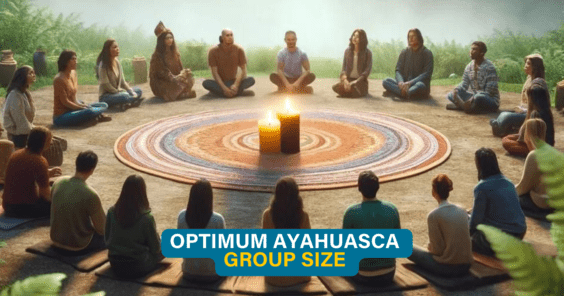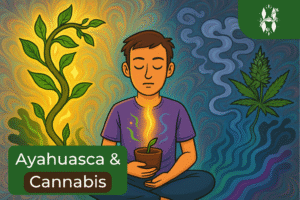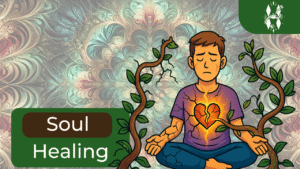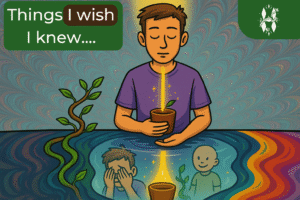Finding the right group size for your Ayahuasca experience is a delicate balance of personal preference and the collective energies that different group dynamics bring. The dynamics of a small group compared to a larger one can significantly affect your experience. From the level of personal attention you receive as well as the energy and intimacy of the session.
In this blog, we dive into why the number of participants matters and how you can determine the ideal group size for your Ayahuasca experience.
Key takeaways:
- Group energy impacts the shared spiritual journey, providing a space where participants can authentically connect, share vulnerabilities, and learn from each other.
- Emotional triggers during the retreat are opportunities for self-reflection and healing, where participants can explore deeper issues and learn from the reflections provided by others.
- Distractions during ceremonies are inevitable, especially in larger groups. Learning to focus amidst them mirrors challenges in daily life and can enhance personal resilience.
- The number of participants in an Ayahuasca retreat significantly influences the personal attention received and the overall energy, impacting the depth of one’s experience.
Table of Contents
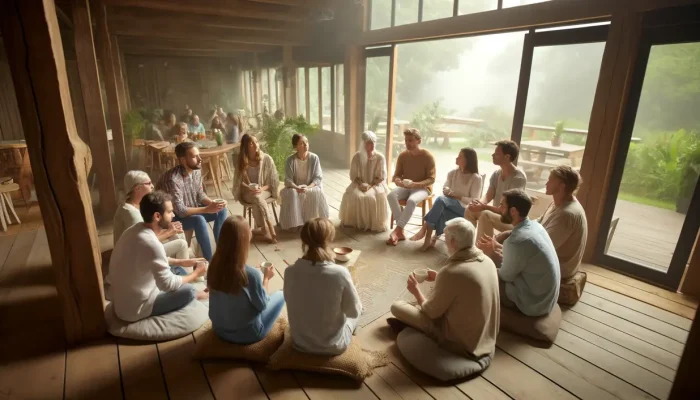
Ayahuasca group size and energy
Group energy plays a big role in the shared journey of an Ayahuasca ceremony. Being inherently social creatures, humans thrive on connection. This need for interaction starts from birth and extends through family life, education, and work environments.
Many emotional challenges arise from feelings of separation or a lack of belonging. Participating in an Ayahuasca ceremony with others offers a unique opportunity to engage in a collective spiritual experience that emphasizes authenticity over social status or achievements.
In the setting of a retreat, the usual masks people have – like the need to appear successful or worldly – fall away. Here, the focus shifts to personal growth and mutual support among participants. This environment allows participants to express themselves authentically, sharing their deepest fears, aspirations, and vulnerabilities without judgment.
This kind of open sharing builds a deep sense of community and compassion. It’s a powerful reminder that we are not alone in our struggles; others face similar or even harder challenges. Hearing others’ stories can put our own problems into perspective, often making us realize that we might prefer our own set of challenges over those of others. Throughout the retreat, as participants reveal more about their inner lives, it becomes clear that there is always more beneath the surface.
Navigating triggers from your Ayahuasca group
Getting triggered by other group members during an Ayahuasca ceremony or retreat is more common than one might expect. These situations offer valuable opportunities for introspection and personal growth. When you find yourself emotionally impacted by someone you’ve known only briefly, it’s helpful to pause and reflect. Ask yourself: What is it about this person that triggers such a strong reaction? What or who do they represent to me? Often, the individuals who trigger us can act as mirrors, reflecting back the unhealed parts of ourselves.
Allowing the trigger to serve as a teacher can be a profound exercise in self-discovery. Through the heightened states facilitated by Ayahuasca, you are given a chance to delve deep into your psyche, exploring the roots of your emotional responses. This process can reveal underlying issues or unresolved emotions, highlighting areas in need of healing.
In this way, those who trigger us during these ceremonies can become some of our greatest teachers.
Must read blog: Ayahuasca Preparation
Distractions during your Ayahuasca ceremony
Distractions are a natural part of any Ayahuasca ceremony, especially as the number of participants increases.
For example, during a ceremony in the jungle, a person outside our group was going through an intense experience, screaming for hours. This situation was understandably frustrating, and there was a desire to minimize the disruption.
When approached about the issue, my mentor Sergio, reminded me that such distractions are part of the ceremony. Just as distractions are a part of everyday life, they also manifest during these spiritual experiences. Sergio’s perspective highlighted an important lesson: the power of choice in where we place our attention. This insight was shared with the participants, helping everyone to refocus on their personal journeys.
Understanding that distractions can be navigated and reframed as part of the experience helps participants to deepen their engagement with their own processes. It’s about learning to maintain focus amidst external chaos, which not only enhances the ceremony but also equips people with skills that are applicable in daily life.
Ceremony consciousness with your Ayahuasca group
“Ceremony consciousness” is a concept within Ayahuasca ceremonies suggesting that everything occurring during the session holds significance. This idea emphasizes the interconnectedness of individual and collective experiences within the ceremonial space.
For example, if a person starts crying during a ceremony, this not only reflects their own emotional release but also becomes a catalyst for other participants’ reactions, each interpreting and responding to the situation based on their personal context and emotional state.
One participant may feel concern, another sadness, or joy in witnessing someone’s breakthrough. Others might not notice at all, or feel annoyed by the distraction, or even envious of the emotional expression they perceive as lacking in their own experience. It also highlights the potential for Ayahuasca to mirror personal patterns, such as those who might prioritize others’ well-being over their own, revealing their tendencies to neglect personal introspection for external attentiveness.
This variety of reactions illustrates how a single event within a ceremony can manifest multiple meanings and lessons, depending on individual perspectives.
“Absorbing” other peoples’ energies in your Ayahuasca group
A common concern among participants in Ayahuasca ceremonies is the fear of “absorbing” the energies of others, especially when they are in an open, receptive state. This worry is understandable.
However, if the ceremony is led by a skilled Ayahuasca shaman, there’s generally no need for concern. A good shaman will continuously work to harmonize the space, ensuring that participants are not adversely affected by each other’s energies. Often, what participants perceive as negative energy in a ceremony may actually be a reflection of their own inner states.
For example, during one ceremony, while one participant was laughing loudly, another expressed feeling an overwhelming sadness. This discrepancy illustrates how individuals can experience and interpret the same environment in very different ways, based on their own emotional and energetic states. The woman who felt sadness was not absorbing negative energy from others; rather, the ceremony’s environment triggered recognition of the sadness she already held within herself.
This highlights the importance of understanding that what we often perceive as external influences are actually manifestations of our internal landscapes. It’s not about absorbing others’ energies but recognizing and addressing our own.
Must read blog: Ayahuasca ceremony – what to expect
Find out if Ayahuasca is right for you
- Will you be safe physically and emotionally?
- How will you be supported in the ceremony?
- How do the facilitators handle difficult situations?
- How will you be able to process the experience?
- You want change, but will your life be unrecognizable after Ayahuasca?
+ 13 things to consider before drinking Ayahuasca?
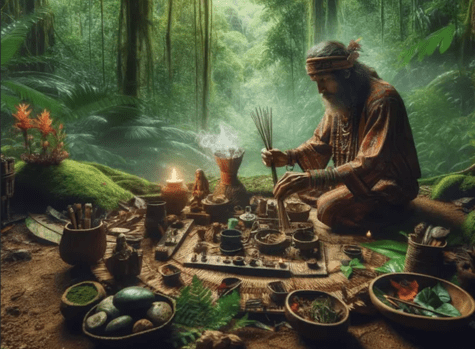
Private Ayahuasca ceremonies
Private Ayahuasca ceremonies appeal to those who seek a more secluded, introspective experience. Many people prefer not to share their most vulnerable moments – like the physical act of vomiting or the emotional display of their inner struggles – with others, especially strangers.
The benefits of a private ceremony
The benefits of a private ceremony can be profound – one of my most memorable ceremonies was when I participated in Ayahuasca alone. The absence of external distractions allowed for an undivided focus on my internal experience, facilitating deep personal insights and significant emotional breakthroughs.
Some people prefer to experience Ayahuasca in a private setting with only close friends or family members – people they trust deeply. This can create a supportive and intimate atmosphere that for some promotes a higher degree of safety and emotional openness.
Whether it’s an individual session or a small, private group, these tailored ceremonies can lead to more profound and meaningful revelations.
Different Ayahuasca group sizes
Ayahuasca group size 5-8 people
I find ceremonies with 5 to 8 participants to be particularly impactful. This group size strikes an excellent balance – it brings about a dynamic group interaction while allowing for lots of individual attention and meaningful conversations. The intimacy of a smaller group can enhance the communal experience, creating such a supportive network.
Having 5 to 8 people is often ideal because it’s enough to have good discussions and hear a range of viewpoints, but not so many people that anyone feels left out. Everyone can get individual attention from the facilitators. This smaller group size helps everyone form tight bonds and supports deep personal growth during the retreat. As well as facilitating deep transformations it enhances a close community feel among participants.
Ayahuasca group size 12-15 people
Leading retreats with 12 to 15 participants is something I am comfortable with, but it requires more facilitators to ensure that each participant receives the personalized attention they need. While the actual ceremony can be managed with a larger group, the important interactions that occur before and after the ceremony – like detailed discussions, personal connections, and follow-up support – are where additional facilitators become necessary.
I place great value on the opportunity to connect personally with each participant. Getting to know them, understanding where they are in their process, and providing words of encouragement are essential parts of the experience I strive to offer. These personal interactions help participants feel safe and supported, enhancing their overall journey and deepening their insights.
The dynamics of larger groups can also lead to a rich exchange of experiences and perspectives. However, ensuring that each participant still feels seen and heard is crucial, and this is heavily dependent on having enough facilitators to cover the needs of the group. Achieving this balance is what allows larger ceremonies to be as impactful and nurturing.
Must read blog: Ayahuasca intention
Ayahuasca group size 18-25 people
When it comes to managing ceremonies with 18 to 25 participants, the physical space and the number of facilitators available are critical factors that influence the quality of the experience. Handling a group of this size can be manageable and can create a vibrant communal atmosphere. However, the setup must be carefully considered.
In scenarios where the ceremony space is limited or there are not enough common areas, the experience can feel cramped and less conducive to personal exploration and comfort. The spatial arrangement needs to support the group’s size, allowing for enough personal space during the ceremony and areas for relaxation and reflection afterward.
With larger groups, the facilitator-to-participant ratio becomes even more crucial. Each participant should feel they have access to guidance and support, which requires a well-coordinated team of facilitators who can effectively manage both the collective needs of the group and the individual concerns that inevitably arise.
Ayahuasca group size 50+ people
Handling Ayahuasca ceremonies with 50 or even 80+ participants introduces a different dynamic – one of constant activity and an increased energy flow. In such settings, there’s always something happening – someone might be vomiting, others might be moving around, and the overall level of noise and activity is significantly higher. Despite the potential for distractions, these ceremonies are well-staffed with helpers to ensure that everyone receives the necessary support.
Participants need to stay disciplined to focus on their personal journey amid the distractions. Some find this raw and unfiltered atmosphere quite authentic and engaging. As one participant expressed “it felt very real”, the lack of a “filter” and the shared communal struggle creates an experience that deeply resonates.
These ceremonies are demanding for facilitators, filled with learning opportunities that require sharp focus and flexibility. However, due to the intensity and potential for overwhelming experiences, I generally wouldn’t recommend such large ceremonies for first-timers. It might be better suited for those who have participated in 10-15 ceremonies and are more used to Ayahuasca. That said, if someone feels a strong call to dive into such an experience early on and is drawn to its intense nature, they should follow their intuition and embrace the challenge.

Harmonizing the energy in smaller Ayahuasca group sizes
One of the key jobs of a shaman or facilitator in an Ayahuasca ceremony is to manage the energy in the space. This is a delicate and complex task because the atmosphere of the ceremony greatly affects how participants experience it.
For example, employing techniques like the use of Waira (wind) can introduce fresh energy and restore harmony, yet for someone intensely experiencing the Ayahuasca, it could further intensify it. In smaller ceremonies, with up to 15 people, facilitators can keep a close watch on each person. This close attention lets them understand how each participant is feeling, even if their personal experiences are private.
How facilitators can help
Facilitators watch for signs like restlessness, heavy breathing, or frequent uncomfortable movements to decide when to step in to adjust the energy. These are important to make sure no one feels overwhelmed. Such group sizes are manageable and generally safe; in three years here, there was only one case that needed serious intervention. The careful handling of Ayahuasca helps ensure that participants have deep, meaningful experiences without losing control.
In larger ceremonies with more than 50 people, things can get intense to the point where physical restraint might be needed to stop someone from harming themselves. While this sounds severe, it’s sometimes necessary to keep things under control. Managing these large ceremonies goes beyond just overseeing the event; facilitators also need to tune into the emotional states of participants before and after the ceremony. Knowing who might be anxious, who is confused, or who needs extra support is crucial for a complete healing experience.
At the Guacamayo Retreat Center, we feel confident handling groups of 7 to 12 people, which is the ideal size for ensuring everyone gets the right amount of attention and support during their Ayahuasca journey.
Conclusion
When deciding on the ideal group size and setting for your Ayahuasca ceremony, the most important factor is honesty with yourself about what environment appeals best to you and what you truly desire.
Reflect on what group size sounds most comfortable to you; consider how the dynamics of different group sizes align with your personal needs for space, intimacy, and individual attention. While the financial aspect is certainly an important consideration, remember that this is not necessarily the experience to economize. Investing in your well-being should be a priority, and sometimes that might mean spending a bit more to ensure you are well cared for.
FAQs
The ideal group size can vary depending on the retreat’s philosophy, the facilities, and the number of facilitators available. Smaller groups (5-8 participants) often provide a more intimate and personal experience, allowing for deeper interaction with the facilitators. Larger groups (12-25 participants), while potentially less personal, can offer a dynamic energy and a diverse range of perspectives. Ultimately, the best size depends on your personal comfort level and what you hope to achieve during the retreat.
The size of the group in an Ayahuasca ceremony influences the collective and individual experiences, known as “ceremony consciousness.” In larger groups, the variety of emotional responses increases, as can the number of observed interactions. Smaller groups provide a more intimate atmosphere, allowing for deeper personal connections and focused guidance. Each group size offers unique benefits, tailored to the participants’ healing and learning preferences. The choice between large and small groups depends on the desired depth of interpersonal dynamics and personal support in the journey.
Group energy is crucial in Ayahuasca retreats, as it enables a collective spiritual journey that emphasizes authenticity and mutual support. Through the retreat, as stories are shared and vulnerabilities exposed, participants gain a deeper understanding of each other, enhancing the communal healing process and highlighting the power of collective empathy. In this setting, participants drop societal facades and share their deepest fears and aspirations without judgment, creating a deep sense of community and compassion. This open sharing helps individuals realize they are not alone in their struggles.
Find out if Ayahuasca is right for you
- Will you be safe physically and emotionally?
- How will you be supported in the ceremony?
- How do the facilitators handle difficult situations?
- How will you be able to process the experience?
- You want change, but will your life be unrecognizable after Ayahuasca?
+ 13 things to consider before drinking Ayahuasca?
